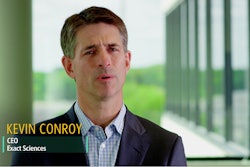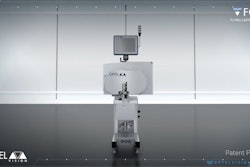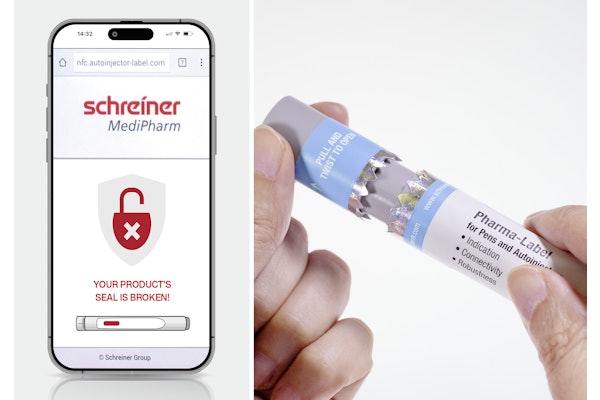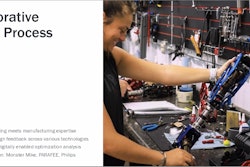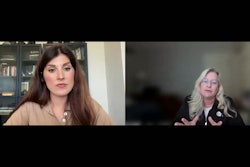At Purdue Pharma's manufacturing and distribution facility in Wilson, NC, RFID is employed on one packaging line for bottles of the company's OxyContin (oxycodone HCl controlled release) tablets. Used for the management of moderate to severe pain, OxyContin is an opioid agonist and a Schedule II controlled substance with an abuse liability similar to morphine.
Mike Celentano, Purdue's associate director of supply chain systems and RFID, explained to the Brand-Protection Packaging Forum audience that the line runs 100 to 110 bottles/min. As bottles are conveyed, the RFID wraparound paper labels are applied much like any label. An in-line reader checks to make sure the RFID tag in the label is readable and that the tag matches the fixed portion of the serial number. The fixed portion of the number carries information about the drug, serving as the National Drug Code, Celentano says. The variable portion of the serial number carries unique numbering. If either portion of the serial number doesn't check out properly, the bottle is rejected.
After labeling, OxyContin bottles are conveyed through a shrink wrapper and are wrapped in six-packs, with eight of these packs manually placed into a shipping case. The case is also RFID labeled. As the closed case conveys downstream, a machine reads 49 total tags, one for the case, and one for each of the 48 bottles. "At this point, we're making an association between the parent [case] and children [bottles], storing that in a database. That's what we call our commissioning event for the bottles, as they're being 'born' with a license plate," suggested Celentano.
He explained that each 1x1-in. RFID inlay consists of an antenna and a chip embedded into the back of each label. NJM/CLI supplied Purdue Pharma with the RFID-enabled case print-and-apply labeler, PLC software, and hardware assembly. Purdue Pharma is using Systechpackaging execution software, Motorola antenna readers and RFID tags, Impinj packaging line readers and reader antennas, and Zebra case labeling, coding, and printing equipment, with George Schmitt serving as the label converter.
"At this point, we've tagged more than two million bottles," said Celentano. "We're seeing performance rates of 99.983 percent in terms of tags that have performed post-packaging. One of the things I attribute that to is a good QA process at our label converter, which identifies and rejects any bad tags before we ever see them. The performance range is acceptable, but no bad tags go out the door. If an RFID tag doesn't read properly, it goes through a rework process so that 100 percent of the bottles go out with readable RFID tags."
Lessons learned
Purdue Pharma has learned several valuable lessons as it's proceeded with its RFID implementation. Here are two key lessons, as reported by Celentano during the recent Brand-Protection Packaging Forum:
• Vendor selection. "There are plenty of vendors out there making tags in various form factors. The same with equipment. We conducted preliminary qualification studies, tested our packaging, and ran it through both our labs and vendor labs to gather some readings on what our potential success might be. We narrowed the field, coordinated vendors for additional testing, and put together protocols. Ours was not an out-of-the-box solution."
• Label trials and tribulations. "We excitedly waited for our first set of RFID labels to arrive in our packaging department. It's not inexpensive to do this. When our engineers went to mount the labels on our labeling equipment, they noticed something funny-each label had a little perforation through the center of it where the RFID chip pushed through the paper label. It turned out the rollstock was wound too tight.
"The supplier backed down on the tensioner and sent us another set of label rollstock with the RFID tags embedded. This second set looked great, but as our engineer moved the web to the packaging line, the entire roll unwound like the world's largest paper telescope. That was two down. Like the story with the three bears, the third time the supplier got the web tensioning just right."
The bar-coding/RFID debate
During their BPPF presentation, Purdue's Aaron Graham and Mike Celentano made it a point to say that the company is open to different technologies, including both RFID and bar coding.
"We had to make decisions early on at some risk as to choosing technologies that we felt the industry would accept," said Celentano. "We had some experience already because of the Wal-Mart initiative, so we decided to move forward with RFID, though we are looking at 2D bar coding as a redundant feature because a lot of our industry partners view it as a more reachable interim solution.
"We use Gen 2 RFID with OxyContin bottles and cases, and we use a linear bar code on pallets. We haven't seen interest at this point from our wholesaler partners to use RFID at the pallet level because pallets have little longevity. When the pallet arrives at a location, it's quickly broken down, so it's more important that cases and items are serialized with RFID tags.
"We're starting to see an acceptance and preference from our major wholesalers for an RFID-based solution. As a company moving thousands of cases of product through its doors every day, and tens of thousands of bottles, we prefer RFID." One key reason for the RFID preference, he says, "is because it doesn't require a line-of-sight technology.



